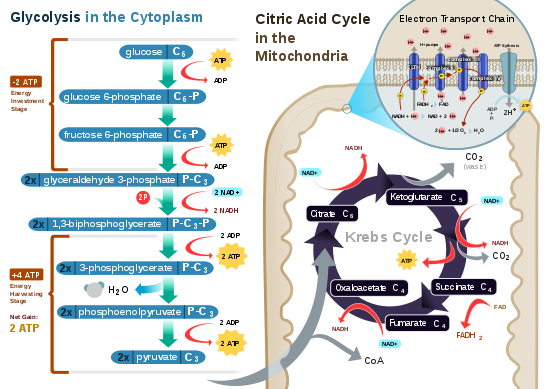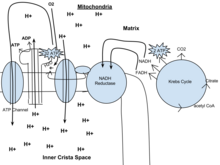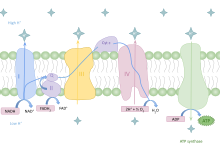Cellular respiration
This article needs editing to comply with Wikipedia's Manual of Style. (September 2023) |
This article needs additional citations for verification. (September 2014) |

Cellular respiration is the process by which biological fuels are
Cellular respiration is a vital process that occurs in the cells of all
The reactions involved in respiration are
Nutrients that are commonly used by animal and plant cells in respiration include
Aerobic respiration
Aerobic respiration requires
| Mass balance of the global reaction: | C6H12O6 (s) + 6 O2 (g) → 6 CO2 (g) + 6 H2O (l) + energy |
| ΔG = −2880 kJ per mol of C6H12O6 |
The negative ΔG indicates that the reaction is exothermic (exergonic) and can occur spontaneously.[citation needed]
The potential of NADH and FADH2 is converted to more ATP through an
Aerobic metabolism is up to 15 times more efficient than anaerobic metabolism (which yields 2 molecules of ATP per 1 molecule of glucose). However, some anaerobic organisms, such as methanogens are able to continue with anaerobic respiration, yielding more ATP by using inorganic molecules other than oxygen as final electron acceptors in the electron transport chain. They share the initial pathway of glycolysis but aerobic metabolism continues with the Krebs cycle and oxidative phosphorylation. The post-glycolytic reactions take place in the mitochondria in eukaryotic cells, and in the cytoplasm in prokaryotic cells.[citation needed]
Although plants are net consumers of carbon dioxide and producers of oxygen via photosynthesis, plant respiration accounts for about half of the CO2 generated annually by terrestrial ecosystems.[5][6]: 87
Glycolysis

- Glucose + 2 NAD+ + 2 Pi + 2 ADP → 2 pyruvate+ 2 H+ + 2 NADH + 2 ATP + 2 H+ + 2 H2O + energy
Starting with glucose, 1 ATP is used to donate a phosphate to glucose to produce glucose 6-phosphate. Glycogen can be converted into glucose 6-phosphate as well with the help of glycogen phosphorylase. During energy metabolism, glucose 6-phosphate becomes fructose 6-phosphate. An additional ATP is used to phosphorylate fructose 6-phosphate into fructose 1,6-bisphosphate by the help of phosphofructokinase. Fructose 1,6-biphosphate then splits into two phosphorylated molecules with three carbon chains which later degrades into pyruvate.[6]: 88–90
Oxidative decarboxylation of pyruvate
Pyruvate is oxidized to acetyl-CoA and CO2 by the pyruvate dehydrogenase complex (PDC). The PDC contains multiple copies of three enzymes and is located in the mitochondria of eukaryotic cells and in the cytosol of prokaryotes. In the conversion of pyruvate to acetyl-CoA, one molecule of NADH and one molecule of CO2 is formed.[citation needed]
Citric acid cycle
The
The citric acid cycle is an 8-step process involving 18 different enzymes and co-enzymes. During the cycle, acetyl-CoA (2 carbons) +
The net gain from one cycle is 3 NADH and 1 FADH2 as hydrogen- (proton plus electron)-carrying compounds and 1 high-energy GTP, which may subsequently be used to produce ATP. Thus, the total yield from 1 glucose molecule (2 pyruvate molecules) is 6 NADH, 2 FADH2, and 2 ATP.[8][9][6]: 90–91
Oxidative phosphorylation
In eukaryotes, oxidative phosphorylation occurs in the mitochondrial

Efficiency of ATP production
The table below describes the reactions involved when one glucose molecule is fully oxidized into carbon dioxide. It is assumed that all the
| Step | coenzyme yield | ATP yield | Source of ATP |
|---|---|---|---|
| Glycolysis preparatory phase | −2 | Phosphorylation of glucose and fructose 6-phosphate uses two ATP from the cytoplasm. | |
| Glycolysis pay-off phase | 4 | Substrate-level phosphorylation | |
| 2 NADH | 3 or 5 | Oxidative phosphorylation: Each NADH produces net 1.5 ATP (instead of usual 2.5) due to NADH transport over the mitochondrial membrane | |
| Oxidative decarboxylation of pyruvate | 2 NADH | 5 | Oxidative phosphorylation |
| Krebs cycle | 2 | Substrate-level phosphorylation | |
| 6 NADH | 15 | Oxidative phosphorylation | |
| 2 FADH2 | 3 | Oxidative phosphorylation | |
| Total yield | 30 or 32 ATP | From the complete oxidation of one glucose molecule to carbon dioxide and oxidation of all the reduced coenzymes. | |
Although there is a theoretical yield of 38 ATP molecules per glucose during cellular respiration, such conditions are generally not realized because of losses such as the cost of moving pyruvate (from glycolysis), phosphate, and ADP (substrates for ATP synthesis) into the mitochondria. All are actively transported using carriers that utilize the stored energy in the proton electrochemical gradient.
- Pyruvate is taken up by a specific, low Km transporter to bring it into the mitochondrial matrix for oxidation by the pyruvate dehydrogenase complex.
- The phosphate carrier (PiC) mediates the electroneutral exchange (antiport) of phosphate (H2PO4−; Pi) for OH− or symport of phosphate and protons (H+) across the inner membrane, and the driving force for moving phosphate ions into the mitochondria is the proton motive force.
- The inner membrane. The driving force is due to the ATP (−4) having a more negative charge than the ADP (−3), and thus it dissipates some of the electrical component of the proton electrochemical gradient.
The outcome of these transport processes using the proton electrochemical gradient is that more than 3 H+ are needed to make 1 ATP. Obviously, this reduces the theoretical efficiency of the whole process and the likely maximum is closer to 28–30 ATP molecules.[4] In practice the efficiency may be even lower because the inner membrane of the mitochondria is slightly leaky to protons.[10] Other factors may also dissipate the proton gradient creating an apparently leaky mitochondria. An uncoupling protein known as thermogenin is expressed in some cell types and is a channel that can transport protons. When this protein is active in the inner membrane it short circuits the coupling between the electron transport chain and ATP synthesis. The potential energy from the proton gradient is not used to make ATP but generates heat. This is particularly important in brown fat thermogenesis of newborn and hibernating mammals.
According to some newer sources, the ATP yield during aerobic respiration is not 36–38, but only about 30–32 ATP molecules / 1 molecule of glucose [11], because:
- ATP : NADH+H+ and ATP : FADH2 ratios during the oxidative phosphorylation appear to be not 3 and 2, but 2.5 and 1.5 respectively. Unlike in the substrate-level phosphorylation, the stoichiometry here is difficult to establish.
- phosphate carrierconsumes 1 H+ / 1 ATP as a result of regeneration of the transmembrane potential changed during this transfer, so the net ratio is 1 ATP : 4 H+.
- The mitochondrial electron transport chain proton pump transfers across the inner membrane 10 H+ / 1 NADH+H+ (4 + 2 + 4) or 6 H+ / 1 FADH2 (2 + 4).
- So the final stoichiometry is
- 1 NADH+H+ : 10 H+ : 10/4 ATP = 1 NADH+H+ : 2.5 ATP
- 1 FADH2 : 6 H+ : 6/4 ATP = 1 FADH2 : 1.5 ATP
- ATP : NADH+H+ coming from glycolysis ratio during the oxidative phosphorylation is
- 1.5, as for FADH2, if hydrogen atoms (2H++2e−) are transferred from cytosolic NADH+H+ to mitochondrial FAD by the glycerol phosphate shuttle located in the inner mitochondrial membrane.
- 2.5 in case of malate-aspartate shuttletransferring hydrogen atoms from cytosolic NADH+H+ to mitochondrial NAD+
So finally we have, per molecule of glucose
- Krebs cycle
- Oxidative phosphorylation
- 2 NADH+H+ from glycolysis: 2 × 1.5 ATP (if glycerol phosphate shuttle transfers hydrogen atoms) or 2 × 2.5 ATP (malate-aspartate shuttle)
- 2 NADH+H+ from the oxidative decarboxylation of pyruvate and 6 from Krebs cycle: 8 × 2.5 ATP
- 2 FADH2 from the Krebs cycle: 2 × 1.5 ATP
Altogether this gives 4 + 3 (or 5) + 20 + 3 = 30 (or 32) ATP per molecule of glucose
These figures may still require further tweaking as new structural details become available. The above value of 3 H+/ATP for the synthase assumes that the synthase translocates 9 protons, and produces 3 ATP, per rotation. The number of protons depends on the number of c subunits in the Fo c-ring, and it is now known that this is 10 in yeast Fo[12] and 8 for vertebrates.[13] Including one H+ for the transport reactions, this means that synthesis of one ATP requires 1 + 10/3 = 4.33 protons in yeast and 1 + 8/3 = 3.67 in vertebrates. This would imply that in human mitochondria the 10 protons from oxidizing NADH would produce 2.72 ATP (instead of 2.5) and the 6 protons from oxidizing succinate or ubiquinol would produce 1.64 ATP (instead of 1.5). This is consistent with experimental results within the margin of error described in a recent review.[14]
The total ATP yield in ethanol or lactic acid
Fermentation
Without oxygen, pyruvate (pyruvic acid) is not metabolized by cellular respiration but undergoes a process of fermentation. The pyruvate is not transported into the mitochondrion but remains in the cytoplasm, where it is converted to waste products that may be removed from the cell. This serves the purpose of oxidizing the electron carriers so that they can perform glycolysis again and removing the excess pyruvate. Fermentation oxidizes NADH to NAD+ so it can be re-used in glycolysis. In the absence of oxygen, fermentation prevents the buildup of NADH in the cytoplasm and provides NAD+ for glycolysis. This waste product varies depending on the organism. In skeletal muscles, the waste product is lactic acid. This type of fermentation is called lactic acid fermentation. In strenuous exercise, when energy demands exceed energy supply, the respiratory chain cannot process all of the hydrogen atoms joined by NADH. During anaerobic glycolysis, NAD+ regenerates when pairs of hydrogen combine with pyruvate to form lactate. Lactate formation is catalyzed by lactate dehydrogenase in a reversible reaction. Lactate can also be used as an indirect precursor for liver glycogen. During recovery, when oxygen becomes available, NAD+ attaches to hydrogen from lactate to form ATP. In yeast, the waste products are ethanol and carbon dioxide. This type of fermentation is known as alcoholic or ethanol fermentation. The ATP generated in this process is made by substrate-level phosphorylation, which does not require oxygen.
Fermentation is less efficient at using the energy from glucose: only 2 ATP are produced per glucose, compared to the 38 ATP per glucose nominally produced by aerobic respiration. Glycolytic ATP, however, is produced more quickly. For prokaryotes to continue a rapid growth rate when they are shifted from an aerobic environment to an anaerobic environment, they must increase the rate of the glycolytic reactions. For multicellular organisms, during short bursts of strenuous activity, muscle cells use fermentation to supplement the ATP production from the slower aerobic respiration, so fermentation may be used by a cell even before the oxygen levels are depleted, as is the case in sports that do not require athletes to pace themselves, such as sprinting.
Anaerobic respiration
Cellular respiration is the process of which biological fuels are oxidised in the presence of an inorganic electron acceptor such as oxygen to produce large amounts of energy, to drive the bulk production of ATP.
Anaerobic respiration is used by microorganisms either
In July 2019, a scientific study of
See also
- Maintenance respiration: maintenance as a functional component of cellular respiration
- Microphysiometry
- Pasteur point
- Respirometry: research tool to explore cellular respiration
- Tetrazolium chloride: cellular respiration indicator
- Complex 1: NADH:ubiquinone oxidoreductes
References
- ^ Bailey, Regina. "Cellular Respiration". Archived from the original on 2012-05-05.
- ^ "Cellular respiration and why it is important - Respiration - AQA Synergy - GCSE Combined Science Revision - AQA Synergy - BBC Bitesize". www.bbc.co.uk. Retrieved 2023-12-07.
- ^ "2.30 Anaerobic and Aerobic Respiration".
- ^ PMID 14641005.
- ISBN 9780470016176.
- ^ ISBN 978-1-4020-3956-0.
- ^ Reece, Jane; Urry, Lisa; Cain, Michael; Wasserman, Steven; Minorsky, Peter; Jackson, Robert (2010). Campbell Biology Ninth Edition. Pearson Education, Inc. p. 168.
- ^ a b R. Caspi (2012-11-14). "Pathway: TCA cycle III (animals)". MetaCyc Metabolic Pathway Database. Retrieved 2022-06-20.
- ^ a b R. Caspi (2011-12-19). "Pathway: TCA cycle I (prokaryotic)". MetaCyc Metabolic Pathway Database. Retrieved 2022-06-20.
- PMID 7654171.
- ^ ISBN 978-0716720096.
- PMID 10576729.
- PMID 20847295.
- PMID 15620362.
- ^ Lumen Boundless Microbiology. "Anaerobic Respiration-Electron Donors and Acceptors in Anaerobic Respiration". courses.lumenlearning.org. Boundless.com. Retrieved November 19, 2020.
Anaerobic respiration is the formation of ATP without oxygen. This method still incorporates the respiratory electron transport chain, but without using oxygen as the terminal electron acceptor. Instead, molecules such as sulfate (SO42-), nitrate (NO3–), or sulfur (S) are used as electron acceptors
- S2CID 199636268.
- ^ World’s Oldest Groundwater Supports Life Through Water-Rock Chemistry Archived 2019-09-10 at the Wayback Machine, July 29, 2019, deepcarbon.net.
- ^ Strange life-forms found deep in a mine point to vast 'underground Galapagos' Archived 2019-09-09 at the Wayback Machine, By Corey S. Powell, Sept. 7, 2019, nbcnews.com.

